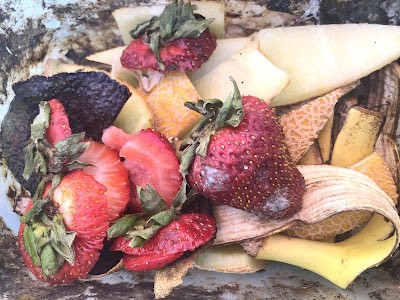
New rules mean rethinking which compost bin to use

|
|
Now there's a breakfast fit for worms: Berry stems,
melon rinds, banana peel and avocado skin. If you
are not a vermicomposter, all this can go in a regular
compost bin or into the organic waste collection can.
(Photo: Kathy Morrison)
|
Here's the scenario I imagine in my kitchen tomorrow as the state's new organic waste law goes into effect:
Me: "OK, the worms certainly get the melon rinds, the strawberry stems, the carrot peelings and the wilty spinach."
Other Me: "Wait, the carrot peelings and the spinach should be frozen with the onion ends to make vegetable broth."
Me: "Oh, right. And the worms don't like onions. Or citrus. So my compost bin at the community garden should get the moldy lemon, along with the dried-out garlic cloves, the corn husks and the cobs."
Other Me: "But corn cobs never break down fast enough in that compost bin. You really should chop things up better and turn them more often."
Me: "Uh, thanks for making me feel guilty about not turning my compost. But here's a solution: The corn cobs now can go into the green waste, I mean Organic Waste, container. Along with the dead flowers from that vase, that rock-hard cheddar cheese, the super-stale leftover crackers and the rest of the hummus I forgot about until it turned moldy."
Other Me: "Well, you COULD grind up the crackers to bread chicken. But storage is a problem when the freezer's so full. OK, just be sure to also throw in the used tea bags -- so glad we like a brand without staples or tags. And while you're at it, round up any wine corks (natural, not plastic) and toss those in, too."
Me: "Wine corks, really? OK, got a few of those."
Other Me: "The skin from last night's grilled fish, too. And the paper towel you used to dry the fish before seasoning it."
Me: "Wow, that bin's going to be stinky. I'll put some newspaper in the bottom, and cover up all this stuff with the stems I cut off my cured garlic crop."
Other Me: "Fight stinky with stinky! Good idea. By the way, don't forget to peel the sticker off the melon rind. Worms don't like plastic."
And ... scene!
Yes, it's going to take even compost veterans a bit of adjustment. But we can do it. The planet's worth it.
For more information on complying with the new law, check out these sites for Sacramento County residents, depending on where you live:
-- Folsom
-- Elk Grove
-- County of Sacramento (all unincorporated areas)
And if you'd like to know more about composting at home , especially worm composting , the links take you to great information from the UCCE Sacramento County master gardeners. Then during Harvest Day, on Aug. 6, come check out the compost set-up at the Fair Oaks Horticulture Center. Learn to keep all that rich, soil-building compost for yourself!
Comments
0 comments have been posted.Sacramento Digs Gardening to your inbox.
Sites We Like
Garden Checklist for week of July 21
Your garden needs you!
* Keep your vegetable garden watered, mulched and weeded. Water before 8 a.m. to reduce the chance of fungal infection and to conserve moisture.
* Feed vegetable plants bone meal, rock phosphate or other fertilizers high in phosphate to stimulate more blooms and fruiting. (But wait until daily high temperatures drop out of the 100s.)
* Don’t let tomatoes wilt or dry out completely. Give tomatoes a deep watering two to three times a week.
* Harvest vegetables promptly to encourage plants to produce more. Squash especially tends to grow rapidly in hot weather. Keep an eye on zucchini.
* Pinch back chrysanthemums for bushy plants and more flowers in September.
* Remove spent flowers from roses, daylilies and other bloomers as they finish flowering.
* Pinch off blooms from basil so the plant will grow more leaves.
* Cut back lavender after flowering to promote a second bloom.
* It's not too late to add a splash of color. Plant petunias, snapdragons, zinnias and marigolds.
* From seed, plant corn, pumpkins, radishes, winter squash and sunflowers.